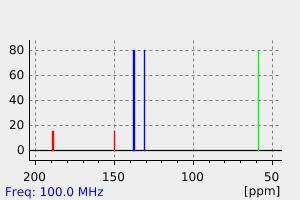2-(羟基甲基)-2,5-环己二烯-1,4-二酮 | 644-17-7
中文名称
2-(羟基甲基)-2,5-环己二烯-1,4-二酮
中文别名
——
英文名称
2-hydroxymethyl-1,4-benzoquinone
英文别名
2-Hydroxymethyl-1,4-benzochinon;gentisyl quinone;2-(hydroxymethyl)cyclohexa-2,5-diene-1,4-dione
CAS
644-17-7
化学式
C7H6O3
mdl
MFCD01663152
分子量
138.123
InChiKey
MTRBCJLZPRDOGJ-UHFFFAOYSA-N
BEILSTEIN
——
EINECS
——
-
物化性质
-
计算性质
-
ADMET
-
安全信息
-
SDS
-
制备方法与用途
-
上下游信息
-
文献信息
-
表征谱图
-
同类化合物
-
相关功能分类
-
相关结构分类
计算性质
-
辛醇/水分配系数(LogP):0
-
重原子数:10
-
可旋转键数:1
-
环数:1.0
-
sp3杂化的碳原子比例:0.142
-
拓扑面积:54.4
-
氢给体数:1
-
氢受体数:3
SDS
上下游信息
反应信息
-
作为反应物:描述:参考文献:名称:Regioselective, Abnormal Ring Opening of the Epoxide of Quinone Epoxide–Cyclopentadiene Adducts摘要:用硫酸处理醌环氧化物–环戊二烯加合物产生了异常开环产物,其结构通过光谱数据和降解产物的鉴定确定。反应的区域选择性得到了确认。讨论了反应机制。DOI:10.1246/bcsj.51.826
-
作为产物:参考文献:名称:单取代和双取代的1,4-二甲氧基苯的阳极氧化摘要:单的电化学氧化和二取代的1,4-二甲氧基苯衍生物与零个,一个,和两个苄基CH 2 X基团(X = OAC,氯,OH)(图5a - ç和图6a - c)中已通过使用进行在甲醇中以及在存在不同电解质和工作电极的情况下进行恒流和控制电位技术的研究。在KOH-甲醇溶液中恒流电解主要从5a - c和6b生成相应的1,4-醌衍生物,而双取代的1,4-二甲氧基苯6a,c进行侧链氧化形成2,5-二甲氧基对苯二甲醛。在将介质从常用的碱性KOH-甲醇更改为中性LiClO 4-甲醇后,在大多数情况下获得了新的产品范围,涉及单取代底物的新型偶联产物和双取代底物的醌衍生物。在玻璃碳阳极和中性LiClO 4-甲醇介质中的受控电势氧化导致产物的更复杂混合物,即单取代的底物和醌的聚合物和新的偶联产物,以及来自碳原子的侧链氧化(或取代)产物。双取代的。分离了三种新的偶联产物,并通过X射线测量对其进行了表征。DOI:10.1021/jo0302253
文献信息
-
New Drug Delivery System for Crossing the Blood Brain Barrier申请人:Lipshutz H. Bruce公开号:US20070203080A1公开(公告)日:2007-08-30New ubiquinol analogs are disclosed, as well as methods of using these compounds to deliver drug moieties to the body.新的泛醌类似物被披露,以及利用这些化合物将药物基团输送到人体的方法。
-
μ-Oxo-Bridged Hypervalent Iodine(III) Compound as an Extreme Oxidant for Aqueous Oxidations作者:Yasuyuki Kita、Toshifumi Dohi、Tomofumi Nakae、Naoko Takenaga、Teruyoshi Uchiyama、Kei-ichiro Fukushima、Hiromichi FujiokaDOI:10.1055/s-0031-1290579日期:2012.4compared to conventional phenyliodine(III) diacetate and bis(trifluoroacetate), as a result of the rapid oxidation of both phenols and naphthols 2. Furthermore, the oxidation reactions proceeded even in water using water-soluble μ-oxo oxidant 1, which has promise for μ-oxo-bridged reagent 1 to become the favored reagent over hydrophobic phenyliodine(III) diacetate and bis(trifluoroacetate).摘要 我们发现在水氧化中,μ-氧桥联的高价碘三氟乙酸盐试剂1 [((PhI(OCOCF 3)] 2 O})通常比相应的单体试剂更具反应性,尤其是对酚醛底物。1在由此提供脱芳构化醌水性介质3中在大多数情况下优异的产率相对于常规phenyliodine(III),二乙酸二(三氟乙酸盐),因为这两个苯酚和萘酚的快速氧化的结果2。此外,氧化反应的进行,甚至在水中使用水溶性μ-氧代氧化剂1,它有望用于μ-氧代桥联试剂1成为优于疏水性二乙酸苯基碘(III)和双(三氟乙酸盐)的首选试剂。 我们发现在水氧化中,μ-氧桥联的高价碘三氟乙酸盐试剂1 [((PhI(OCOCF 3)] 2 O})通常比相应的单体试剂更具反应性,尤其是对酚醛底物。1在由此提供脱芳构化醌水性介质3中在大多数情况下优异的产率相对于常规phenyliodine(III),二乙酸二(三氟乙酸盐),因为这两个苯酚和萘酚的快速氧化的结果2
-
Hypervalent Iodine Oxidation of<i>p</i>-Alkoxy- and Related Phenols: A Facile and Efficient Synthesis of<i>p</i>-Quinones作者:Yasumitsu Tamura、Takayuki Yakura、Hirofumi Tohma、Kazumi Ki-kuchi、Yasuyuki KitaDOI:10.1055/s-1989-27170日期:——(Ditrifluoroacetoxyiodo)benzene oxidizes p-alkoxy- and related phenols to the corresponding p-quinones in excellent yields under mild conditions.
-
Development of new and efficient polymer-supported hypervalent iodine reagents作者:Simon Ficht、Marcel Mülbaier、Athanassios GiannisDOI:10.1016/s0040-4020(01)00424-0日期:2001.6The aminomethylpolystyrene-supported (diacetoxyiodo)benzene reagents 4a and 4b were prepared for the first time. Using these reagents several hydroquinones and phenols can be oxidized to the corresponding quinones. Spirocyclization of phenylacetic acid and of N-protected tyrosine derivatives could also be accomplished.
-
Access to functionalized quinones via the aromatic oxidation of phenols bearing an alcohol or olefinic function catalyzed by supported iron phthalocyanine作者:Olga V. Zalomaeva、Alexander B. SorokinDOI:10.1039/b608834a日期:——The controlled oxidation at only one position of compounds with several oxidizable sites, while keeping the other sites intact, has been demonstrated for phenols bearing alcohol or olefinic functional groups. Iron tetrasulfophthalocyanine supported on silica was found to be an efficient catalyst for the preparation of functionalized quinones under mild conditions, with tert-butylhydroperoxide as the
表征谱图
-
氢谱1HNMR
-
质谱MS
-
碳谱13CNMR
-
红外IR
-
拉曼Raman
-
峰位数据
-
峰位匹配
-
表征信息
同类化合物
(反式)-4-壬烯醛
(s)-2,3-二羟基丙酸甲酯
([1-(甲氧基甲基)-1H-1,2,4-三唑-5-基](苯基)甲酮)
(Z)-4-辛烯醛
(S)-氨基甲酸酯β-D-O-葡糖醛酸
(S)-3-(((2,2-二氟-1-羟基-7-(甲基磺酰基)-2,3-二氢-1H-茚满-4-基)氧基)-5-氟苄腈
(R)-氨基甲酸酯β-D-O-葡糖醛酸
(5,5-二甲基-2-(哌啶-2-基)环己烷-1,3-二酮)
(2,5-二氟苯基)-4-哌啶基-甲酮
龙胆苦苷
龙胆二糖甲乙酮氰醇(P)
龙胆二糖丙酮氰醇(P)
龙胆三糖
龙涎酮
齐罗硅酮
齐留通beta-D-葡糖苷酸
鼠李糖
黑芥子苷单钾盐
黑海棉酸钠盐
黑木金合欢素
黑曲霉三糖
黑介子苷
黄尿酸8-O-葡糖苷
麻西那霉素II
麦迪霉素
麦芽糖脎
麦芽糖基海藻糖
麦芽糖1-磷酸酯
麦芽糖
麦芽四糖醇
麦芽四糖
麦芽十糖
麦芽六糖
麦芽五糖水合物
麦芽五糖
麦芽五糖
麦芽五糖
麦芽三糖醇
麦芽三糖
麦芽三糖
麦芽三塘水合
麦芽七糖水合物
麦芽七糖
麦法朵
麦可酚酸-酰基-Β-D-葡糖苷酸
麦利查咪
麝香酮
鹤草酚
鸢尾酚酮 3-C-beta-D-吡喃葡萄糖苷
鸡矢藤苷







